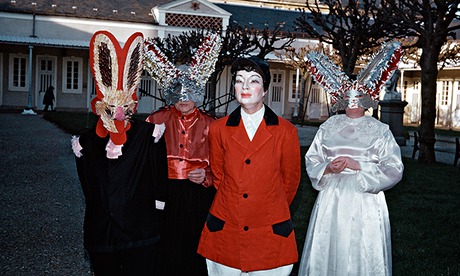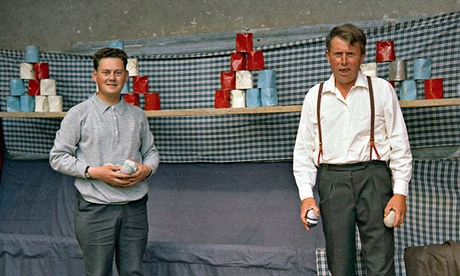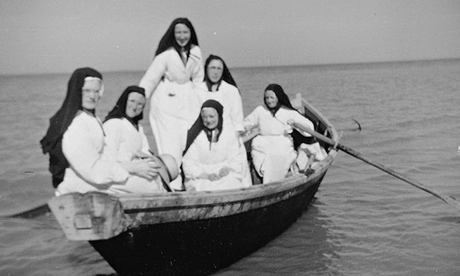'The extraordinary and the banal': snapshots from a psychiatric hospital'The extraordinary and the banal': snapshots from a psychiatric hospital
• Inside a 20th-century psychiatric hospital – in pictures
theguardian.com, Wednesday 19 February 2014 03.39 AEST

The nuns kept a record of everything. Trips to the fun fair, plays and pet orangutans were all documented at a small psychiatric hospital at Picauville in Normandy. In 2010, when the old building was due to be demolished, the French photographer Mathieu Pernot and historian Philippe Artières were given its vast photography archive, and charged with the task of showing what life there was like over the years. Their findings, called L'Asile des Photographies (Asylum for Photographs), are astonishing.
The pair uncovered decades of droll snaps and day-trip memorabilia, ID photos and institution interiors, all on show now at the Maison Rouge arts centre in Paris. Every shot has added intrigue because the names of the photographers and subjects were never recorded, and there's rarely any indication of dates. All they know is that most of the images prior to 1944 were lost because the hospital was heavily bombed during the second world war.
 'Disquieting strangeness' ... Kermesse, hôpital de Picauville (Manche). Photograph: Archives Fondation Bon-Sauveur
'Disquieting strangeness' ... Kermesse, hôpital de Picauville (Manche). Photograph: Archives Fondation Bon-SauveurNone of the documents have been retouched; Artières and Pernot agreed that the images feel "spectacular as they are". Their power comes from the mystery surrounding these nameless, timeless beings – and how counterintuitively banal their everyday lives look. Artières explains that the role of photography had a looser function in the 20th century, "unlike in the 19th century, which consisted of photographing symptoms" – such as the images of hysteria recorded by French neurologist Jean-Martin Charcot. Artières likens the images, instead, to lighthearted family photos. "You don't take family photos when someone is crying, but on birthdays," he notes. "In the same way, you don't take pictures of patients in crisis mode."
Artières describes their project as a "cartography of the hospital, a medical lexicon and image souvenirs that are at once banal and extraordinary". On entering the show, a roomful of stained single mattresses are tied down with string to rusted bed frames. This installation seems purposefully misleading, given the tone of the images to follow, but Artières says he was "leaving room for silence". Less sinister than cryptic, you at once feel your lack of knowledge about the fragile lives being depicted.
 Day-trippers ... Photograph: Archives Fondation Bon-Sauveur
Day-trippers ... Photograph: Archives Fondation Bon-SauveurThere's an amusing section dedicated to the nuns who ran the institution, photographed in an improbably playful series of activities: picnicking, rowing boats. Nearby, seven images show theatre productions from 1937: little girls on stage in hats and gloves, ensemble casts in white robes. One image is just a plush stage curtain, heavily drawn, emanating something surreal and cinematic à la David Lynch.
There's also an inventory of lost and found items photographed on solemn white backgrounds by Pernot, including a mask (like something right out of a Ralph Eugene Meatyard photo), a frightening-looking metal collar and a shiny Jesus on a wooden cross.
Pernot also shot a contemporary series of the now-ramshackle hospital in 2010: an operating room emptied of machinery, a bathroom with two adjacent tubs, a hallway cluttered with sticks and a lone green leaf growing through the floor.
And then there are the Super 8 films of the hospital residents and nuns daytripping at the beach. In one, women in sensible skirts run repeatedly, almost manically, up and down a ramp. In another, an orangutan wearing a jumpsuit plays with nuns and patients to everyone's delight, before being put back in a cage. There is a disquieting strangeness to these scenes that stops them from being simple afternoon frolics in the fresh Normandy air. "You can see the violence in the bodies, on their faces … little gestures," says Artières.
The duo feel that the archive is less an exposé of the history of psychiatry than a reveal about the history of photography itself. "There's a strong porosity between the social history and the photographic history," says Artières – and L'Asile des Photographies certainly shows how photography can have multiple social meanings. Though the facts of these people's existence are now indecipherable, the images are incredibly resonant. They tell of the past and all it contains: the lives of people we glimpse but never know.

Comments
What a powerful collection. It really highlights how little we really know about the past. Such anonymity is a challenge to us. I guess it keeps us motivated to keep saving the past.